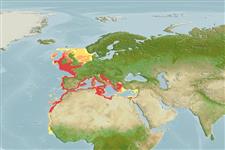Common names from other countries
>
Eupercaria/misc (Various families in series Eupercaria) >
Cepolidae (Bandfishes) > Cepolinae
Etymology: Cepola: Latin, cepulla = onion.
More on author: Linnaeus.
Environment: milieu / climate zone / depth range / distribution range
Ecologia
marino demersale; distribuzione batimetrica 15 - 400 m. Subtropical; 61°N - 10°N, 18°W - 36°E
Eastern Atlantic: British Isles to north of Senegal, including the Mediterranean.
Length at first maturity / Size / Peso / Age
Maturity: Lm 24.2 range ? - ? cm
Max length : 80.0 cm TL maschio/sesso non determinato; (Ref. 27156); common length : 40.0 cm TL maschio/sesso non determinato; (Ref. 26999)
Spine dorsali (totale) : 0; Raggi dorsali molli (totale) : 67 - 70; Raggi anali molli: 60. Body ribbon-like, gradually tapering to a pointed tail. Large, oblique mouth. Teeth widely spaced on both jaws. First two rays of dorsal fin unsegmented. Caudal fin with median rays longer and free at their tip. Dorsal and anal fins more or less joined to the caudal fin.
Found on sand and mud bottom (Ref. 26999). Lives in vertical burrows but may be found swimming in midwater. Occurs singly or in groups. Feeds mainly on small crustaceans and chaetognaths (Ref. 5984).
Eggs are pelagic.
Quéro, J.-C., 1990. Cepolidae. p. 853-854. In J.C. Quero, J.C. Hureau, C. Karrer, A. Post and L. Saldanha (eds.) Check-list of the fishes of the eastern tropical Atlantic (CLOFETA). JNICT, Lisbon; SEI, Paris; and UNESCO, Paris. Vol. 2. (Ref. 5985)
IUCN Red List Status (Ref. 130435)
CITES (Ref. 128078)
Not Evaluated
Threat to humans
Harmless
Human uses
Pesca: scarso interesse commerciale
Strumenti
Special reports
Download XML
Fonti Internet
Estimates based on models
Preferred temperature (Ref.
115969): 9.8 - 16.5, mean 11.9 (based on 326 cells).
Phylogenetic diversity index (Ref.
82804): PD
50 = 0.5312 [Uniqueness, from 0.5 = low to 2.0 = high].
Bayesian length-weight: a=0.00380 (0.00284 - 0.00508), b=2.42 (2.34 - 2.50), in cm Total Length, based on LWR estimates for this species (Ref.
93245).
Trophic level (Ref.
69278): 3.1 ±0.23 se; based on food items.
Resilienza (Ref.
120179): Medio, tempo minimo di raddoppiamento della popolazione 1.4 - 4.4 anni (K=0.21; tmax=8).
Fishing Vulnerability (Ref.
59153): Moderate to high vulnerability (55 of 100).
Climate Vulnerability (Ref.
125649): Moderate vulnerability (38 of 100).
